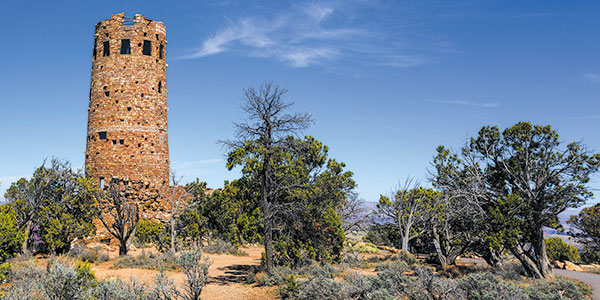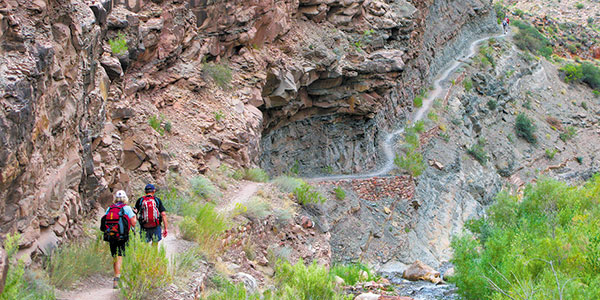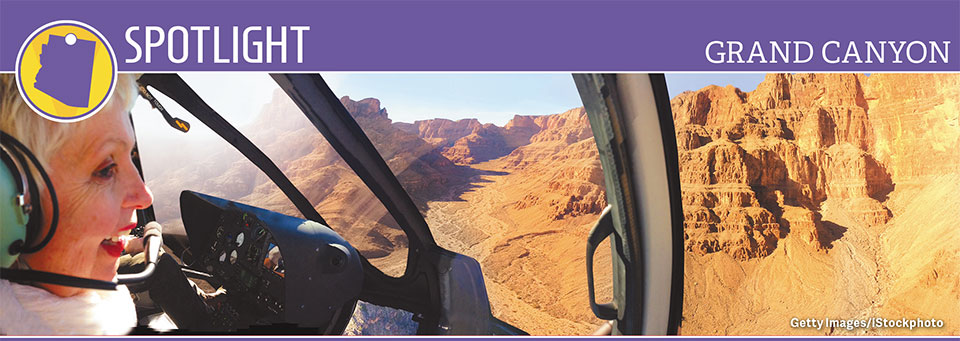Grand Canyon
Considered the world’s seventh natural wonder, the Grand Canyon will mesmerize, enthrall and make the heart valves squeak. The 277-mile-long, 18-mile-wide gorge composed of lofty buttes, rugged peaks, rippling rock faces, yawning gorges and stratified mesas drenched with blazing colors just takes the breath away.
Furrowed over millions of years by the Colorado River, with canyons that descend 6,000 feet, this is hard-core nature. For the intrepid adventurer, rafting, hiking, biking, helicopter tours and horseback riding into the canyon’s deepest, darkest recesses are just some of the available recreational pursuits. Few places on earth fuse primal beauty, epic adventure, and ancient culture into such a family-friendly package. Fortunately, travelers of all stripes can enjoy it.
South Rim: Desert View Driving Tour
For the faint of heart, or travelers with limited time, the formidable canyons can be played out with Technicolor glory from the window of your RV. The most accessible driving routes are the South Rim’s Desert View Drive, which follows the rim for 25 miles out to the Desert View Watchtower and the East Entrance. On this scenic route, you will see more of the canyon than on either the Cape Royal or Hermit roads (two of the canyon’s other iconic routes). If you want to escape the crowds (relatively speaking), head for the North Rim, which is open from May to October.
The South Rim is easily accessible by car from Highway 64, which leads to Grand Canyon Village, a National Historic Landmark district that’s neatly tucked inside the park’s southern gate. The South Rim’s western overlooks afford spectacular vistas of the central canyon while, to the northeast, the dazzling expanse of sheer cliffs, known as the “Palisades of the Desert,” form the southeastern wall of the Grand Canyon. A worthy stop-off point along the route, the 825-year-old Tusayan Ruin and Museum, a Pueblo Indian site, is considered one of the most important archeological sites in Arizona.
Just a half-mile west of Desert View, Navajo Point overlooks Colorado’s “big bend” area and provides exhilarating views of the Grand Canyon Supergroup, a formation of igneous and sedimentary Precambrian rocks that, in many other parts of the canyon, have completely eroded. From here, you can also see the much-photographed whose symbolic potency bookends the drive rather fittingly. Designed by Mary Colter, the 70-foot-high stone structure, modeled after ancient pueblo towers found at Mesa Verde and Hovenweep, seems to emerge organically from the earth.

Grand Canyon National Park
Grand Hiking
A hiker’s Shangri-La, the Grand Canyon boasts some of the country’s cleanest air, with visibility (on clear days) ranging from 90 to 110 miles. While the majority of Grand Canyon National Park’s 1,904 square miles are protected as wilderness, it can be challenging, still, to get off the beaten path. The South Rim, the most popular side with hikers (some 5 million every year), stands at an elevation of 7,000 feet. The Colorado River, the carving force behind the canyon, lies one vertical mile below. You can take your pick of rim trails, corridor trails, and wilderness trails. Not wanting to state the obvious, rim trails snake the canyon’s rim and traverse the park’s more developed (and, therefore, populated) areas.
As rim trails do not descend into the bowels of the canyon, they are usually paved with gradual inclines. The scenic, well-maintained North Kaibab, South Kaibab and Bright Angel corridor trails are the best options for first-timers as they are regularly patrolled by park rangers and provide access to backcountry campgrounds. Unless you are looking for more of a challenge—in the form of strewn boulders, steep declines, and bewildering, often washed-away trails—steer clear of the wilderness trails; with few rangers in these parts, you’ll have to wait a while if you need help.
Due to strenuous one-day hike in and out prerequisites, most visitors don’t make it to the bottom of the canyon. If that’s your bold undertaking, it’s best to plan an overnight hike into the canyon via the Bright Angel Trail (a 10-mile hike from the South Rim to Phantom Ranch), or, just to the east, the more vertiginous South Kaibab Trail (a 7-mile hike to Phantom Ranch). Phantom Ranch provides sufficient creature comforts for the two-day trip, with a campground, basic cabins, and meals available.

Grand Canyon National Park
Nature Unbound
Ascending from the canyon floor to the top of the North Rim is a biological odyssey. There are more than 1,500 plant and 400 vertebrate species, ranging from insect-eating bats to 1,000-pound elk roaming the rims. The Grand Canyon’s immense biological diversity can be credited to the existence of five of North America’s seven life zones (Lower Sonoran, Upper Sonoran, Transition, Canadian, and Hudsonian) and three of the nation’s four desert categories. Basically, a journey through the Grand Canyon delivers the same life zone exposure as you would experience traveling from Mexico to Canada.
The canyon’s climate is semi-arid, with some sections of the upper plateau dotted with forests, while the canyon bottoms are a series of desert basins. According to current geological theories, the Grand Canyon’s genesis stems from constant erosion by the Colorado River that began between 5 and 6 million years ago; the canyon’s mile-high walls reveal a largely undisturbed cross-section of the Earth’s crust extending back some 2 billion years.
An estimated 1,500 plant, 355 bird, 89 mammalian, 47 reptile, 9 amphibian, 17 fish species and thousands of aquatic and terrestrial invertebrate species speak to the evolution of the planet. The park also serves as an ecological refuge, with relatively undisturbed vestiges of declining ecosystems (such as desert riparian communities and boreal forest).
For More Information
Grand Canyon National Park
928-638-7888
www.nps.gov/grca
Arizona Office of Tourism
866-275-5816
www.arizonaguide.com







